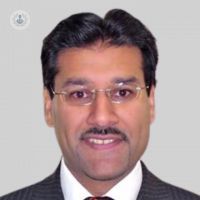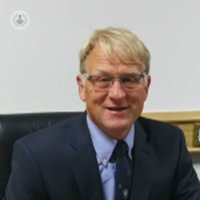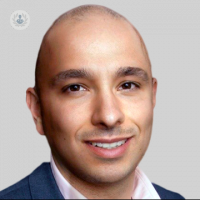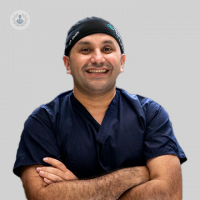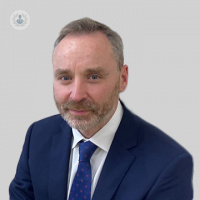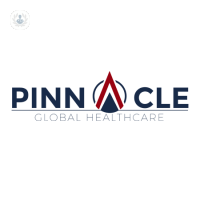What is the shoulder?
The shoulder is the part that serves as the link between the arm and the body. It is formed by the union of the ends of three bones: the clavicle, the scapula (shoulder blade) and the humerus, as well as muscles, ligaments and tendons.
The main shoulder joint connects the head of the humerus and the scapula, or shoulder blade, and is called the scapulohumeral joint. It has two joint surfaces (one corresponding to the head of the humerus and the other to the glenoid cavity of the shoulder blade). The head of the arm bone fits into a rounded cavity in the shoulder blade. Both surfaces are covered with cartilage to allow smooth, painless movement.
In addition, a set of muscles and tendons attach to the surfaces of the bones, allowing joint mobility. These include the rotator cuff, formed by four muscles that give mobility and stability to the shoulder.
The shoulder joint has a greater range of motion than all other joints in the body.
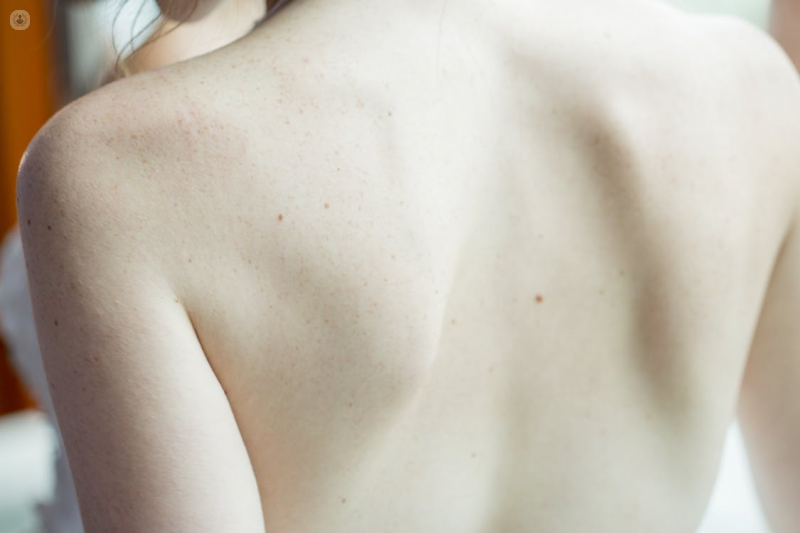
Shoulder function
The shoulder enables a wide range of movements in the arm, allowing us to write, use cutlery, scratch our back, swim, and play certain sports that require the use of our arms (including basketball, handball, and tennis).
Shoulder pathologies
Shoulder pathologies generally fall into 4 categories:
- Inflammation of the tendon (bursitis or tendonitis), or tearing of the tendon
- Joint dislocation
- Osteoarthritis
- Bone fracture
Less frequent are tumours, infection, and nerve-related problems.
The main shoulder pathologies are:
- Bursitis: there are a number of small fluid-filled sacs located in the shoulder and in joints throughout the body. Overuse of the shoulder can sometimes lead to inflammation or swelling of the sac between the rotator cuff and the shoulder blade.
- Tendonitis: the tendon is a kind of cord that connects muscle and bone. Most tendonitis is due to tendon wear. It can be acute, or chronic when caused by a degenerative disease. The most commonly affected tendons are the four rotator cuff tendons and one of the bicep tendons.
- Tendon tears: these may result from acute injuries or degenerative changes due to ageing or prolonged overuse. They may be partial or complete. Rotator cuff and biceps tendon tears are the most common.
- Compression: this occurs when the upper part of the shoulder blade presses on the underlying soft tissues when lifting the arm away from the body. As the arm is lifted, the part of the shoulder blade compresses the rotator cuff tendons and sac. This causes pain and may lead to tendonitis or bursitis. If left untreated, compression could lead to a torn rotator cuff.
- Dislocation: this occurs when the head of the arm bone is forced out of the shoulder socket. It can be caused by sudden injury or overuse. A shoulder dislocation can be partial or complete.
Which specialist treats shoulder pathologies?
Shoulder pathologies are usually treated by an orthopaedic surgeon, and depending on the injury, a physiotherapist. If the cause of your shoulder problem was osteoarthritis, it is also likely that you will be treated by a rheumatologist.
11-13-2012 08-03-2023Shoulder
What is the shoulder?
The shoulder is the part that serves as the link between the arm and the body. It is formed by the union of the ends of three bones: the clavicle, the scapula (shoulder blade) and the humerus, as well as muscles, ligaments and tendons.
The main shoulder joint connects the head of the humerus and the scapula, or shoulder blade, and is called the scapulohumeral joint. It has two joint surfaces (one corresponding to the head of the humerus and the other to the glenoid cavity of the shoulder blade). The head of the arm bone fits into a rounded cavity in the shoulder blade. Both surfaces are covered with cartilage to allow smooth, painless movement.
In addition, a set of muscles and tendons attach to the surfaces of the bones, allowing joint mobility. These include the rotator cuff, formed by four muscles that give mobility and stability to the shoulder.
The shoulder joint has a greater range of motion than all other joints in the body.

Shoulder function
The shoulder enables a wide range of movements in the arm, allowing us to write, use cutlery, scratch our back, swim, and play certain sports that require the use of our arms (including basketball, handball, and tennis).
Shoulder pathologies
Shoulder pathologies generally fall into 4 categories:
- Inflammation of the tendon (bursitis or tendonitis), or tearing of the tendon
- Joint dislocation
- Osteoarthritis
- Bone fracture
Less frequent are tumours, infection, and nerve-related problems.
The main shoulder pathologies are:
- Bursitis: there are a number of small fluid-filled sacs located in the shoulder and in joints throughout the body. Overuse of the shoulder can sometimes lead to inflammation or swelling of the sac between the rotator cuff and the shoulder blade.
- Tendonitis: the tendon is a kind of cord that connects muscle and bone. Most tendonitis is due to tendon wear. It can be acute, or chronic when caused by a degenerative disease. The most commonly affected tendons are the four rotator cuff tendons and one of the bicep tendons.
- Tendon tears: these may result from acute injuries or degenerative changes due to ageing or prolonged overuse. They may be partial or complete. Rotator cuff and biceps tendon tears are the most common.
- Compression: this occurs when the upper part of the shoulder blade presses on the underlying soft tissues when lifting the arm away from the body. As the arm is lifted, the part of the shoulder blade compresses the rotator cuff tendons and sac. This causes pain and may lead to tendonitis or bursitis. If left untreated, compression could lead to a torn rotator cuff.
- Dislocation: this occurs when the head of the arm bone is forced out of the shoulder socket. It can be caused by sudden injury or overuse. A shoulder dislocation can be partial or complete.
Which specialist treats shoulder pathologies?
Shoulder pathologies are usually treated by an orthopaedic surgeon, and depending on the injury, a physiotherapist. If the cause of your shoulder problem was osteoarthritis, it is also likely that you will be treated by a rheumatologist.
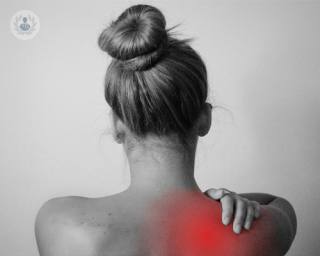

Should I be concerned about shoulder pain while running?
By Ms Susan Alexander
2024-11-21
Are you currently suffering from shoulder pain while running? If so, this article has your all-you-need-to-know guide with regards to why this may be. Here, esteemed consultant orthopaedic surgeon, Ms Susan Alexander, reveals what exactly causes shoulder pain while running, and whether or not it may be a sign of a more serious condition. See more


Exploring new concepts in shoulder replacement
By Mr Andrew Sankey
2024-11-21
Advancements in orthopaedic surgery continue to shape the landscape of joint replacement, and the shoulder is no exception. Esteemed consultant orthopaedic surgeon Mr Andrew Sankey, who specialises in shoulder surgery, aims to provide simple and informative answers to key questions regarding new concepts in shoulder replacement. See more
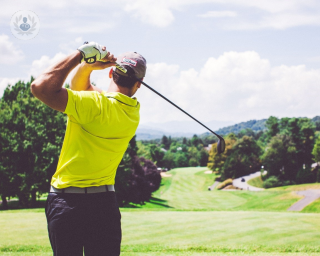

Common injuries affecting golfers
By Mr Ali Al-Sabti
2024-11-21
The golf swing is a fundamental part of the game and poor swinging techniques can injure the shoulders, elbows, hands and wrists. Mr Ali Al-Sabti, a leading orthopaedic surgeon, tells us what the most common golf injuries he’s encountered are and what treatments are available. See more
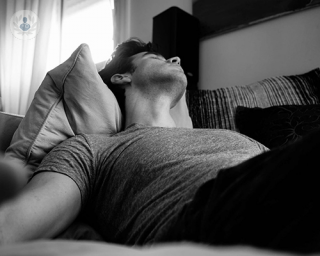

Shoulder pain and sleep solutions
By Mr Nick Ferran
2024-11-21
For those who suffer from shoulder pain, it can have a knock-on effect when it comes to getting a good night's sleep. It may be difficult finding a comfortable sleeping position and leave sufferers with sleepless nights. Expert orthopaedic surgeon Mr Nick Ferran explains what patients can do to get some rest. See more
Experts in Shoulder
-
Mr Richard Hill
Orthopaedic surgeryExpert in:
- Shoulder
- Elbow
- Arthroplasty
- Hip replacement
- Shockwave therapy
- Platelet-rich plasma
-
Mr Neil Jain
Orthopaedic surgeryExpert in:
- Knee
- Shoulder
- Sports injuries
- Tendon injuries
- Joint preservation surgery
- Sports surgery
-
Mr Amer Khan
Orthopaedic surgeryExpert in:
- Sports injuries
- Shoulder
- Knee arthroscopy
- ACL reconstruction
- Meniscus
- Cartilage repair
-
Professor Mohamed Imam
Orthopaedic surgeryExpert in:
- Shoulder
- Fracture
- Wrist surgery
- Hand surgery
- Arthroscopy of small joints
- Elbow
-
Mr Colin Senior
Orthopaedic surgeryExpert in:
- Shoulder
- Shoulder arthroscopy
- Shoulder replacement
- Traumatic injury
- Sports injuries
- Rotator cuff injury
- See all

Dundee Outpatient Centre - part of Circle Health Group
Dundee Outpatient Centre - part of Circle Health Group
Heal Physiotherapy, 14 Dudhope Street, Dundee DD1 1JU
No existe teléfono en el centro.
By using the telephone number provided by TOP DOCTORS, you automatically agree to let us use your phone number for statistical and commercial purposes. For further information, read our Privacy Policy
Top Doctors

New Victoria Hospital
New Victoria Hospital
184 Coombe Lane West, Kingston upon Thames, KT2 7EG
No existe teléfono en el centro.
By using the telephone number provided by TOP DOCTORS, you automatically agree to let us use your phone number for statistical and commercial purposes. For further information, read our Privacy Policy
Top Doctors

Pinnacle Global Healthcare
Pinnacle Global Healthcare
13 Lichfield Road
No existe teléfono en el centro.
By using the telephone number provided by TOP DOCTORS, you automatically agree to let us use your phone number for statistical and commercial purposes. For further information, read our Privacy Policy
Top Doctors
-
Dundee Outpatient Centre - part of Circle Health Group
Heal Physiotherapy, 14 Dudhope Street, Dundee DD1 1JU, DundeeExpert in:
- General Surgery
- Orthopaedic surgery
- Physiotherapy
- Shoulder and elbow
- Urology
-
New Victoria Hospital
184 Coombe Lane West, Kingston upon Thames, KT2 7EG, South LondonExpert in:
- Cardiology
- General Surgery
- Orthopaedic surgery
- Breast augmentation
- Pain management
- Spine
-
Pinnacle Global Healthcare
13 Lichfield Road, StaffordExpert in:
- Orthopaedic surgery
- Diagnostics
- Pain management
- Physiotherapy
- Sports Medicine
- Regenerative Medicine
- See all
- Most viewed diseases, medical tests, and treatments
- Migraine
- Joint pain
- Lumbar herniated disc
- Abdominal pain
- Spinal surgery
- Minimal access surgery (keyhole surgery)
- Shoulder pain
- Expert witness
- Osteoporosis
- Lifestyle medicine
